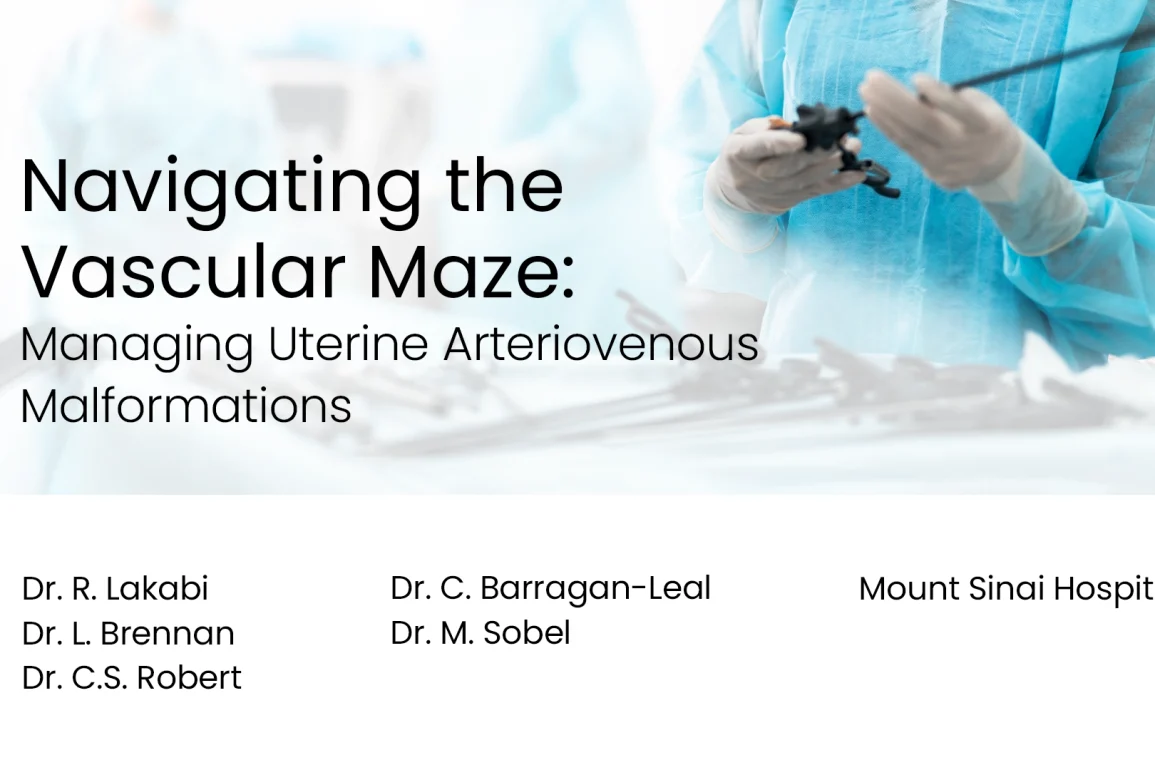Table of Contents
- Procedure Summary
- Authors
- Youtube Video
- What are Uterine Arteriovenous Malformations?
- What are the Risks of Uterine Arteriovenous Malformations?
- Video Transcript
Video Description
A surgical walkthrough on diagnosing and managing uterine arteriovenous malformations, with tips on avoiding hemorrhage and preserving uterine function.
Presented By
Affiliations
Mount Sinai Hospital
Watch on YouTube
Click here to watch this video on YouTube.
What are Uterine Arteriovenous Malformations?
Uterine arteriovenous malformations (AVMs) are rare vascular abnormalities where there is a direct connection between uterine arteries and veins, creating a high-flow fistula. Here’s what is important to know:
- Definition and Types: AVMs can be congenital (present from birth) or acquired, often following uterine trauma such as cesarean delivery, curettage, myomectomy, or infection.
- Clinical Presentation: Patients typically present with heavy, recurrent, or life-threatening vaginal bleeding that does not respond to routine medical management.
- Diagnosis: Doppler ultrasound is often the first test and shows high-velocity turbulent flow; angiography remains the gold standard for definitive diagnosis and treatment planning.
- Management Options: Depending on lesion size, blood flow, and fertility goals, treatment may include expectant management, hormonal therapy, uterine artery embolization, or hysterectomy in severe or refractory cases.
What are the Risks of Uterine Arteriovenous Malformations?
Uterine AVMs carry significant risks due to their abnormal, high-flow vascular connections.
- Massive Hemorrhage: Sudden, severe uterine bleeding can lead to hypovolemic shock and require emergency transfusion or surgery.
- Hemodynamic Instability: Rapid blood loss may cause hypotension, tachycardia, or cardiovascular collapse.
- Thromboembolism: High-flow lesions and interventional procedures such as embolization increase the risk of venous thromboembolism.
- Infection: Repeated bleeding, procedures, or retained tissue can lead to pelvic infection or abscess formation.
- Fertility Impact: Embolization or surgical treatment can reduce uterine perfusion, impair implantation, or necessitate hysterectomy.
- Recurrence or Residual Lesion: Incomplete treatment may allow persistent shunting and recurrent bleeding.
Prompt diagnosis, careful imaging, and a multidisciplinary approach – often involving interventional radiology and gynecologic surgery – are essential to reduce these risks and preserve reproductive potential when possible.
Video Transcript:
Today, we present navigating the vascular maze, managing uterine arteriovenous malformation. Today’s objectives will be to review AVMs of the treatment options. We will then present our surgical approach to a hysterectomy for a large AVM.
We present the case of a healthy 26-year-old G2P2 with two previous c-sections and no other uterine instrumentation. She presented multiple times to the emergency department with significant vaginal bleeding, which did not improve with OCP and TXA. An ultrasound revealed a large vascular abnormality, with a peak systolic velocity of 150 cm per second. As we can appreciate it here, the MRI revealed a significant uterine AVM.
AVMs are vascular fistulas defined as an abnormal connection between arteries and vein. They are rare, but the associated bleeding can be life threatening. They are either congenital or acquired. Although angiography is the diagnostic gold standard, ultrasound is an emerging and promising modality. Multiple risk factors have been identified for acquired AVMs, such as any disruption of the uterine cavity. Other factors are malignancy, gestational trophoblastic disease, infection, and DES exposure.
Given the absence of standardisation treatment selection algorithms have been hypothesised in the literature. Expectant management would be acceptable in small AVMs with a slow peak systolic velocity. For larger ones with a PSV between 40 to 60 cm per second, medical treatment would be recommended. An interventional approach is favoured with faster PSVs. Patient factors also contribute to treatment selection, including age, hemodynamic stability, fertility goals, and overall patient’s perspective.
Given the clinical picture, the patient’s fertility goals, and the size and the PSV of the AVM, an interventional approach was favoured. The patient was therefore offered embolization or a hysterectomy. Interventional radiology was consulted, and a CT angio confirmed the AVM.
Here, we can appreciate the angiogram showing bilateral AV shunting, and that no AVM nidus remained following temporary occlusion. As such, according to IR, embolization was reasonable, but they cautioned against systemic embolization risk and the risk of failure.
The patient opted for a hysterectomy for which she was consented. For preop planning, we recommend the following, ensuring patient’s understanding of procedures implication, anaemia optimisation using IV iron and TXA. Preop cross-matching of at least four units. A chest X-ray to allow gestational trophoblastic disease, vascular surgery on standby, and a preop IR consult for internal iliac balloon placement to be inflated intraop.
Intraop, we advised securing the uterine blood supply before placing a uterine manipulator to avoid AVM disruptions. Blood supply can be secured by ligating the uterine arteries or the anterior division of the internal iliac. IR balloons can be used as an alternative or an adjunct. Against the usual instinct, we encourage dissecting closer to the bladder to avoid the AVM.
Starting on the right side, we identified the right ureter and the obliterated umbilical artery, above which we opened the retroperitoneum. Of note, to avoid using the uterine manipulator, we divided the mesosalpinx and utero-ovarian pedicles first to improve exposure to the side wall. After ureterolysis, we used the obliterated umbilical artery to identify the uterine artery origin and the interior division of the internal iliac 2 cm below the iliac bifurcation. We ligated both arteries with metal clips.
Anatomical variations may impact the feasibility of securing either vessels. We showed both, given accessibility, AVM size, and for teaching purposes. The same procedure was then reproduced on the left side. After securing both vessels, we then placed the uterine manipulator under direct visualisation. Of note, in our institution, we use the RUMI® manipulator.
We then turned our attention to the bladder. Given the central position of the AVM and the previous c-sections, we favoured a lateral to medial approach. We used a combination of monopolar cautery and ligature sealing device to dissect the anterior leaf of the broad ligament.
Given the dense adhesions between the bladder and the uterus, we inflated the bladder with the CO2 gas from the laparoscopic setup to outline the borders of the bladder.
With traction and counter traction, using the laparoscopic instruments and the urine manipulator, we identified the level of the pubocervical fascia. Once both uterine arteries were transacted at the internal os, we tunnelled our instruments under the adhesion formed by the previous c-section scar at the level of the AVM. This freed the bladder. We alternated between both sides as the dissection became easier with every millimetre released on either side.
Once the adhesion was completely skeletonised, we were able to divide it while remaining closer to the bladder to avoid the AVM. We then completed the colpotomy and extracted the specimen vaginally. We then sutured the vaginal vault. Here, we can appreciate the integrity of a bladder wall during cystoscopy. The patient had an uncomplicated recovery, and she was able to be discharged on post-op day one with an adequate haemoglobin.
In conclusion, when dealing with AVMs, a multidisciplinary approach is strongly encouraged, especially with interventional radiology. If surgical approach is chosen, efforts should be directed at decreasing the blood flow to the uterus. This can be done surgically or with IR balloons. Lastly, against usual instincts, it is important to stay closer to the bladder while dissecting it to avoid the…



